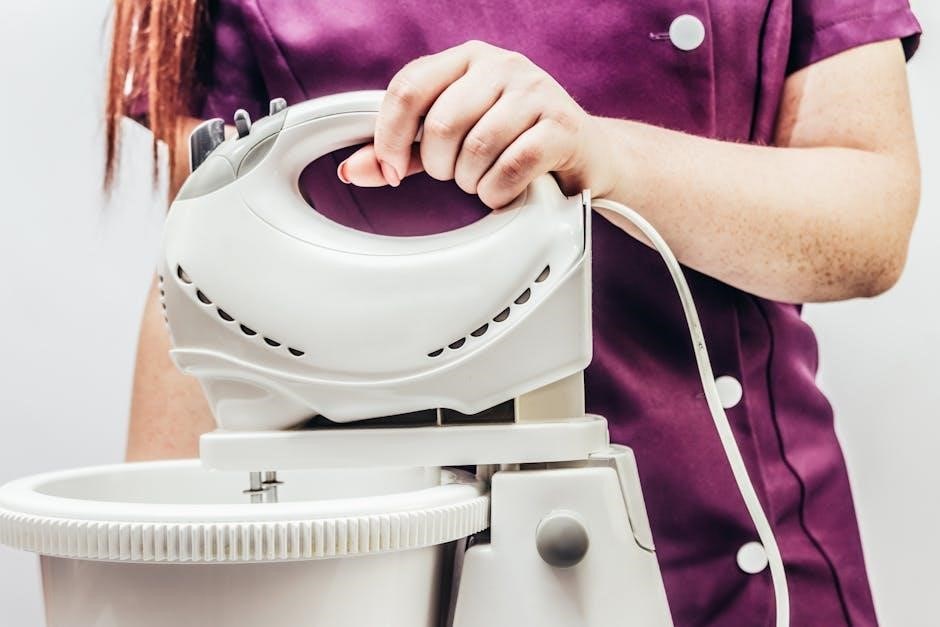Welcome to the Verdant Thermostat Manual. This guide provides comprehensive instructions for installing, configuring, and operating your Verdant VX Series thermostat. Explore its features, troubleshooting, and maintenance tips for optimal energy management and comfort control.
1.1 Overview of the Verdant Thermostat System
The Verdant Thermostat System is a cutting-edge, energy-efficient solution designed to optimize heating, cooling, and ventilation in various environments. It features a wireless control card and an occupancy sensor for smart, automated operation. The system is ideal for spaces like apartments, hotels, and commercial buildings, offering precise temperature control and energy-saving presets. Its intuitive interface allows users to customize settings, ensuring comfort and efficiency. The thermostat integrates seamlessly with external devices, such as lighting and air dampers, making it a comprehensive energy management tool.

1.2 Importance of Reading the Manual

Reading the Verdant Thermostat Manual is essential for understanding the system’s features, operation, and maintenance. It provides detailed guidance on installation, configuration, and troubleshooting, ensuring optimal performance. By following the manual, users can personalize settings, troubleshoot common issues, and maximize energy efficiency. The manual also covers critical topics like occupancy sensor calibration and energy-saving presets, helping users achieve comfort while reducing energy consumption. Proper understanding of the manual prevents errors and ensures the thermostat operates as intended, delivering reliable and efficient climate control.
1.3 Key Features of the Verdant Thermostat

The Verdant Thermostat offers advanced features designed for comfort and efficiency. It includes an occupancy sensor that adjusts settings based on room activity, smart energy management to optimize consumption, and compatibility with smart home systems for seamless integration. The thermostat also features a user-friendly interface with a backlit display, allowing easy navigation and adjustments. Additional highlights include customizable schedules, temperature limits, and remote access via mobile devices. These features ensure precise control, energy savings, and enhanced convenience for users.
Installation and Setup
This section guides you through the Verdant Thermostat installation process, including pre-installation checks, wiring requirements, and initial setup steps for a smooth and efficient setup experience.

2.1 Pre-Installation Checks

Before installing the Verdant Thermostat, ensure your system is compatible with the thermostat’s requirements. Verify that the heating, cooling, and ventilation systems are compatible with the thermostat’s voltage and wiring configuration. Check for any existing smart home integrations to ensure seamless connectivity. Ensure the power is turned off at the circuit breaker before starting the installation. Gather all necessary tools and materials, such as screwdrivers and wire strippers. Review the wiring diagram provided in the manual to understand the connections. Finally, ensure the area is clear and safe for installation.
2.2 Installing the Wireless Control Card
To install the wireless control card, first ensure the thermostat is powered off. Locate the wireless control card slot on the back or side of the thermostat. Remove the cover gently using a screwdriver if necessary. Insert the card into the slot, ensuring it clicks securely into place. Replace the cover and screw it back if required. Power on the thermostat and check for wireless connectivity. Test communication with the system to confirm proper installation. Refer to the manual for specific card orientation and alignment details.
2.3 Wiring Connections and Requirements
Ensure the power is off before connecting any wires. Use 18-24 AWG wires for all connections. Connect the R (red) wire to the power terminal and W (white) to heat. Y (yellow) is for cooling, and G (green) controls the fan. C (common) wire is essential for proper operation. Verify all connections are secure and match the terminal designations on the thermostat. If unsure, consult a licensed electrician. Double-check wiring before restoring power to avoid damage or safety hazards. Follow the manual’s wiring diagram for accurate connections. Test the system after wiring to ensure functionality. Always prioritize safety during installation. Use a voltage tester to confirm power is off before starting work. Proper wiring ensures reliable performance and prevents potential malfunctions. If your system requires additional wiring, refer to the manual’s specific guidelines for compatibility and requirements. Avoid using damaged or frayed wires, as they can lead to system issues. Ensure all wires are securely fastened to prevent loose connections. If you encounter any wiring issues, consult the troubleshooting section or contact a professional. Always follow local electrical codes and safety standards when handling wiring. This ensures compliance and prevents hazards. Use the provided wire nuts or connectors for secure connections. Do not overload terminals with multiple wires unless specified. Keep wires organized to avoid tangles or damage. If your system uses zone control, ensure the wiring matches the zone configuration. Test each wire connection individually to confirm proper functionality. Use a multimeter to verify continuity and voltage levels. Proper wiring is critical for optimal thermostat performance and energy efficiency. If you are unsure about any step, consider hiring a professional to ensure correct installation. Always turn off the power at the circuit breaker before handling any wiring. Use the correct tools to strip and connect wires safely. Avoid touching live wires or terminals to prevent electrical shock; If you notice any damage to the wires or terminals, replace them immediately. Proper wiring ensures seamless communication between components, enhancing system reliability. Follow the manufacturer’s guidelines for wire lengths and routing to maintain performance. Use the provided wiring diagram as a reference for accurate connections. Secure all wires neatly to prevent interference or damage. If you are installing in a new location, plan the wiring route carefully to avoid obstacles. Use wire clips or ties to keep wires organized and secure. Ensure all connections are tight and free from corrosion. Apply a small amount of dielectric grease to terminals if recommended. If you are upgrading from an older system, verify compatibility with existing wiring. Update wiring if necessary to meet current standards. Always follow the manufacturer’s instructions for wiring configurations specific to your system. Use the correct gauge wire to prevent overheating or voltage drop. If you are installing in a high-voltage area, take extra precautions to ensure safety. Use insulated tools and wear protective gear when handling live wires. Double-check all connections before restoring power to ensure they are correct. If you encounter any issues during testing, refer to the troubleshooting guide or contact support. Proper wiring is essential for optimal performance, safety, and energy efficiency. Always prioritize caution when working with electrical systems. If you are unsure about any aspect of the wiring process, seek professional assistance to avoid potential risks. Use the provided wiring accessories to ensure compatibility and reliability. Keep all wiring connections clean and dry to prevent short circuits. If you are installing in a humid environment, use moisture-resistant wires and connectors. Ensure all wires are securely fastened to prevent vibration damage. If you are installing in a commercial setting, ensure compliance with local electrical codes and regulations. Use the correct wiring colors to match the system’s requirements. Test each connection individually to confirm proper installation. Use a wiring checklist to ensure all steps are completed correctly. If you are installing multiple thermostats, ensure each system’s wiring is isolated to prevent interference. Use the correct wire connectors to prevent corrosion and ensure longevity. If you are installing in a high-traffic area, secure wires to prevent accidental damage. Use the provided wiring templates to ensure accurate connections. Double-check all wiring before finalizing the installation. If you are upgrading from an older system, ensure all wiring meets current safety standards. Use the correct tools to avoid damaging the wires or terminals. If you are installing in a sensitive environment, take extra precautions to prevent static discharge. Use anti-static wrist straps or mats when handling sensitive components. Ensure all wires are properly labeled for future reference. Use the provided wire labels or create your own for clarity. If you are installing in a large space, plan the wiring route carefully to avoid signal loss. Use the correct wire type for long-distance connections to prevent signal degradation. If you are installing multiple components, ensure all wiring is compatible and properly connected. Use the correct gauge wire for the distance to prevent voltage drop. If you are installing in a noisy environment, use shielded wires to prevent interference. Use the correct connectors to ensure secure and reliable connections. If you are installing in a corrosive environment, use wires and connectors resistant to corrosion. Ensure all wiring connections are tight and free from oxidation. Use the correct torque when tightening terminals to avoid damage. If you are installing in a high-temperature area, use heat-resistant wires and connectors. Ensure all wiring is rated for the operating temperature of the environment. Use the correct insulation type for the wires to prevent melting or degradation. If you are installing in a high-humidity area, use wires and connectors with moisture-resistant ratings. Ensure all wiring is securely sealed to prevent water ingress. Use the correct wire ties to keep wires organized and secure. If you are installing in a vibration-prone area, use wires and connectors with vibration-resistant ratings. Ensure all wiring is securely fastened to prevent loosening over time. Use the correct tools to ensure all connections are secure and reliable. If you are installing in a sensitive electronic environment, use wires with proper shielding to prevent EMI. Ensure all wiring is routed away from sources of interference. Use the correct wire clips to keep wires organized and prevent damage. If you are installing in a confined space, plan the wiring route carefully to avoid overcrowding. Use the correct wire management tools to keep wires neat and secure. If you are installing multiple systems, ensure all wiring is properly isolated to prevent cross-talk. Use the correct wire separators to keep wires organized and prevent tangling. If you are installing in a high-security area, use wires with proper shielding to prevent signal interception. Ensure all wiring is securely fastened to prevent tampering. Use the correct wire locks to prevent unauthorized access. If you are installing in a remote location, ensure all wiring is properly insulated to withstand environmental conditions. Use the correct wire type for outdoor installations to prevent damage from weather. Ensure all wiring connections are sealed to prevent water ingress. Use the correct wire connectors with weather-resistant ratings. If you are installing in a subzero environment, use wires and connectors rated for low temperatures. Ensure all wiring is properly insulated to prevent freezing. Use the correct wire type for extreme temperatures to maintain performance. If you are installing in a high-altitude area, ensure all wiring is rated for the operating conditions. Use the correct wire type to prevent damage from low air pressure. Ensure all wiring connections are secure to prevent loosening due to altitude changes. If you are installing in a marine environment, use wires and connectors resistant to saltwater corrosion. Ensure all wiring is properly sealed to prevent moisture ingress. Use the correct wire type for marine environments to maintain reliability. If you are installing in a dusty environment, use wires and connectors with dust-resistant ratings. Ensure all wiring is properly sealed to prevent contamination. Use the correct wire type for dusty environments to maintain performance. If you are installing in a chemical plant, use wires and connectors resistant to chemical corrosion. Ensure all wiring is properly sealed to prevent chemical ingress. Use the correct wire type for chemical environments to maintain safety and reliability. If you are installing in a nuclear facility, use wires and connectors resistant to radiation. Ensure all wiring is properly shielded to prevent radiation interference. Use the correct wire type for nuclear environments to maintain safety and performance. If you are installing in a medical facility, use wires and connectors with proper shielding to prevent EMI. Ensure all wiring is properly insulated to prevent patient risk. Use the correct wire type for medical environments to maintain safety and reliability. If you are installing in a data center, use wires and connectors with proper shielding to prevent data loss. Ensure all wiring is properly routed to avoid interference. Use the correct wire type for data centers to maintain performance and reliability. If you are installing in a laboratory, use wires and connectors resistant to chemical and
2.4 Mounting the Thermostat
Mount the thermostat on a flat, dry wall surface, ideally 52-60 inches above the floor. Choose a location with consistent room temperature. Use the provided mounting bracket and screws to secure the thermostat. Ensure the wall can support the weight of the device. Drill pilot holes if necessary and use wall anchors for stability. Align the thermostat level to ensure accurate temperature readings. Tighten all screws firmly but avoid overtightening. If installing on a plaster or drywall, use appropriate anchors. Refer to the manual for specific mounting hardware recommendations. Ensure the thermostat is accessible for easy operation and adjustments. Avoid mounting near drafts or direct sunlight to maintain accurate temperature sensing. If additional stability is needed, use the optional mounting plate. Always follow safety precautions when drilling or handling tools. Ensure the thermostat is securely fastened to prevent movement or vibration. If installing in a humid environment, ensure the mounting area is dry to prevent moisture damage. Use a level tool to confirm proper alignment before finalizing the installation. If unsure about the mounting process, consult a professional for assistance. Proper mounting ensures optimal performance and longevity of the thermostat. Keep the area around the thermostat clear to allow proper air circulation. If installing multiple thermostats, ensure they are spaced appropriately to avoid interference. Use the provided mounting template to mark the wall accurately. Double-check all screws and connections before finalizing the installation. If you encounter any issues during mounting, refer to the troubleshooting section or contact support. Always follow the manufacturer’s guidelines for mounting the thermostat to ensure warranty validity. Use the correct tools to avoid damaging the device or the wall. If you are mounting in a commercial setting, ensure compliance with local building codes and regulations. Use the correct mounting hardware for the type of wall material. If you are unsure about the wall type, consult a professional to avoid damage. Proper mounting ensures the thermostat functions accurately and reliably; Always test the thermostat’s operation after mounting to ensure it is working correctly. If you notice any issues, adjust the mounting or consult the manual for troubleshooting steps. Ensure the thermostat is securely mounted to prevent accidental dislodgement. Use the provided screws and brackets to avoid compatibility issues. If you are installing in a high-traffic area, ensure the thermostat is mounted at a safe height to prevent tampering or damage. Use the correct torque when tightening screws to avoid stripping the threads. If you are installing in a sensitive environment, take extra precautions to prevent damage to the wall or the device. Use a stud finder to locate the best spot for mounting if necessary. Ensure the thermostat is mounted in a location that allows for easy access and visibility. If you are installing in a rented property, consider using removable wall anchors to avoid permanent damage. Use the correct type of screws for the wall material to ensure a secure hold. If you are installing in a historical building, consult with a professional to ensure compliance with preservation standards. Use the correct mounting technique to avoid damaging the wall or surrounding area. If you are installing in a mobile home, ensure the wall can support the weight and use appropriate anchors. Use the correct mounting hardware to prevent loosening over time. If you are installing in a recreational vehicle, ensure the thermostat is securely mounted to withstand movement. Use the correct screws and brackets to maintain stability during travel. If you are installing in a boat, use marine-grade mounting hardware to resist corrosion. Ensure the thermostat is mounted in a dry, well-ventilated area to prevent moisture damage. Use the correct mounting technique to secure the thermostat firmly. If you are installing in an aircraft, use aviation-grade mounting hardware to ensure safety and reliability. Ensure the thermostat is mounted in a location that meets aviation standards and regulations. Use the correct tools and materials to prevent any risk of malfunction. If you are installing in a train or bus, use heavy-duty mounting hardware to withstand constant movement. Ensure the thermostat is securely fastened to prevent vibration damage. Use the correct screws and brackets to maintain stability during operation. If you are installing in a industrial setting, use industrial-grade mounting hardware to ensure durability. Ensure the thermostat is mounted in a location that allows for easy maintenance and access. Use the correct mounting technique to prevent damage from harsh environmental conditions. If you are installing in a laboratory, use mounting hardware that can withstand exposure to chemicals and cleaning agents. Ensure the thermostat is mounted in a location that allows for proper airflow and temperature sensing. Use the correct screws and brackets to maintain a secure hold in a dynamic environment. If you are installing in a medical facility, use mounting hardware that meets medical safety standards. Ensure the thermostat is mounted in a location that allows for easy cleaning and sanitization. Use the correct screws and brackets to prevent contamination or damage. If you are installing in a food processing plant, use mounting hardware that can withstand exposure to moisture and cleaning agents. Ensure the thermostat is mounted in a location that allows for proper airflow and temperature control. Use the correct screws and brackets to maintain a secure hold in a high-moisture environment. If you are installing in a greenhouse, use mounting hardware that can withstand exposure to humidity and temperature fluctuations. Ensure the thermostat is mounted in a location that allows for proper airflow and temperature sensing. Use the correct screws and brackets to maintain stability in a dynamic environment. If you are installing in a server room, use mounting hardware that can withstand exposure to constant heat and airflow. Ensure the thermostat is mounted in a location that allows for proper temperature sensing and control. Use the correct screws and brackets to maintain a secure hold in a high-tech environment. If you are installing in a cleanroom, use mounting hardware that meets cleanroom standards. Ensure the thermostat is mounted in a location that allows for proper airflow and temperature control. Use the correct screws and brackets to prevent contamination or damage. If you are installing in a pharmaceutical facility, use mounting hardware that meets pharmaceutical safety standards. Ensure the thermostat is mounted in a location that allows for proper airflow and temperature sensing. Use the correct screws and brackets to maintain a secure hold in a regulated environment. If you are installing in a museum, use mounting hardware that can withstand exposure to controlled environmental conditions. Ensure the thermostat is mounted in a location that allows for proper airflow and temperature control. Use the correct screws and brackets to maintain stability in a sensitive environment. If you are installing in a library, use mounting hardware that can withstand exposure to quiet and controlled conditions. Ensure the thermostat is mounted in a location that allows for proper airflow and temperature sensing. Use the correct screws and brackets to maintain a secure hold in a low-traffic area. If you are installing in a residential garage, use mounting hardware that can withstand exposure to temperature fluctuations and humidity. Ensure the thermostat is mounted in a location that allows for proper airflow and temperature control. Use the correct screws and brackets to maintain stability in a dynamic environment. If you are installing in a basement, use mounting hardware that can withstand exposure to moisture and humidity. Ensure the thermostat is mounted in a location that allows for proper airflow and temperature sensing. Use the correct screws and brackets to maintain a secure hold in a damp environment. If you are installing in an attic, use mounting hardware that can withstand exposure to high temperatures and humidity. Ensure the thermostat is mounted in a location that allows for proper airflow and temperature control. Use the correct screws and brackets to maintain stability in a high-temperature environment. If you are installing in a crawl space, use mounting hardware that can withstand exposure to moisture and humidity. Ensure the thermostat is mounted in a location that allows for proper airflow and temperature sensing. Use the correct screws and brackets to maintain a secure hold in a confined space. If you are installing in a barn, use mounting hardware that can withstand exposure to temperature fluctuations and humidity. Ensure the thermostat is mounted in a location that allows for proper airflow and temperature control. Use the correct screws and brackets to maintain stability in a rural environment. If you are installing in a shed, use mounting hardware that can withstand exposure to temperature fluctuations and humidity. Ensure the thermostat is mounted in a location that allows for proper airflow and temperature sensing. Use the correct screws and brackets to maintain a secure hold in a small, enclosed space. If you are installing in a greenhouse, use mounting hardware that can withstand exposure to high humidity and temperature fluctuations. Ensure the thermostat is mounted in a location that allows for proper airflow and temperature control. Use the correct screws and brackets to maintain stability in a dynamic environment. If you are installing in a solarium, use mounting hardware that can withstand exposure to high temperatures and humidity. Ensure the thermostat is mounted in a location that allows for proper airflow and temperature sensing. Use the correct screws and brackets to maintain a secure hold in a
2.5 Initial Power-Up and Configuration
After mounting, power up the thermostat by connecting it to the HVAC system and turning on the power supply. The display will light up and begin a self-test. Follow the on-screen prompts to set the date, time, and preferred temperature units. Select your HVAC system type from the menu. The thermostat will then perform a system test to ensure all components are functioning properly. Once the test is complete, you can proceed to set your preferred temperature range and schedule. Save your settings to complete the initial configuration.

Configuration and Settings
Access the menu to customize temperature, scheduling, and energy-saving preferences. Adjust settings to optimize comfort and energy efficiency based on your lifestyle and HVAC system requirements.
3.1 Navigating the Thermostat Menu

Navigate the Verdant Thermostat menu by using the touchscreen or buttons. Press the menu button to access settings, then scroll through options using arrows or swipe gestures. The main menu includes sections like temperature settings, scheduling, and energy management. Submenus appear when selecting specific options, allowing detailed adjustments. Use the back button or exit option to return to the previous screen. The interface is designed for ease of use, with clear labels and visual indicators for selected options. Ensure to save changes before exiting to apply new settings.

3.2 Setting Up the Clock and Room Number
To set up the clock and room number on your Verdant Thermostat, navigate to the menu and select “Clock Settings.” Use the touchscreen or buttons to set the current time, date, and time zone. Ensure accuracy for proper scheduling and energy management. Next, assign a unique room number or name to identify the thermostat’s location, especially in multi-zone systems. This helps differentiate settings and controls. Save your changes to apply them. Accurate clock settings are crucial for automated features, while room numbers simplify system organization and operation.
3.3 Configuring Equipment Settings
Configuring equipment settings on the Verdant Thermostat allows you to tailor its operation to your specific HVAC system. Navigate to the “Equipment Settings” menu and select your system type, such as forced air, radiant, or heat pump. Set the heating and cooling cycles per hour to optimize performance. Adjust the stage configuration if you have a multi-stage system. Ensure compatibility with your equipment by selecting the correct fan and fuel types. Accurate configuration ensures efficient operation and avoids potential system conflicts. Save your settings to apply them.
3.4 Energy Savings and Preset Options
The Verdant Thermostat offers advanced energy-saving features to reduce consumption. Use preset schedules to automatically adjust temperatures during peak hours or when the house is unoccupied. Enable energy-saving mode to limit extreme heating or cooling. Customize energy usage based on your lifestyle by selecting from predefined programs or creating your own. The thermostat also learns your preferences over time to optimize efficiency. These options ensure you save energy without compromising comfort, making it easier to manage your home’s climate responsibly.
3.5 Occupancy Sensor Configuration
Configure the occupancy sensor to optimize energy use based on room activity. Adjust sensitivity levels to detect motion accurately, ensuring the thermostat responds to presence or absence. Set timeout periods to determine how long the system waits before switching to energy-saving mode. Enable or disable the sensor manually if needed. Customizable settings allow you to tailor the sensor’s behavior to your space and habits, enhancing both energy efficiency and comfort. Proper configuration ensures seamless operation and maximizes the thermostat’s smart features.
Operation and Usage
This section guides users through the daily operation of the Verdant Thermostat, covering essential functions like temperature adjustment, mode selection, and energy-efficient feature utilization.
4.1 Understanding the Thermostat Interface
The Verdant Thermostat features an intuitive interface designed for ease of use. The high-resolution touchscreen display provides clear visuals of current temperature, system mode, and active settings. Navigate using the menu button to access options like temperature adjustment, fan control, and energy-saving modes. The interface includes a status bar showing system operation, such as heating, cooling, or idle. Indicator lights on the side signal active functions, while the occupancy sensor LED confirms motion detection. This user-friendly design ensures seamless control over your home’s climate system.
4.2 Setting Temperature Preferences
To set temperature preferences on the Verdant Thermostat, tap the touchscreen to access the main menu. Use the up or down arrows to adjust the desired temperature. For precise control, enter the temperature manually using the number pad. Save your changes by selecting “Done.” You can also schedule temperature adjustments using the Smart Schedule feature, ensuring optimal comfort and energy efficiency throughout the day; The thermostat will confirm your settings with a brief message before returning to the home screen.
4.3 Manual Override and Temporary Adjustments
To manually override the Verdant Thermostat, tap the current temperature on the home screen. Use the up or down arrows to set your desired temperature. Temporary adjustments will override the current schedule but will revert after the next programmed setting or after 24 hours, whichever comes first. To cancel the override, select the cancel option in the menu. This feature is ideal for making quick changes without altering your long-term schedule, ensuring flexibility and convenience.

and Future Directions
4.4 Using the Occupancy Sensor
The occupancy sensor detects movement to automatically adjust the thermostat. It helps optimize energy use by switching to energy-saving modes when no one is present. The sensor is usually located on the front or side of the thermostat. To use it, ensure it is enabled in the menu. Adjust the sensor sensitivity in settings if needed, based on room size or pet activity. The sensor will automatically resume normal operation when movement is detected again, making it a convenient energy-saving feature;


























































































